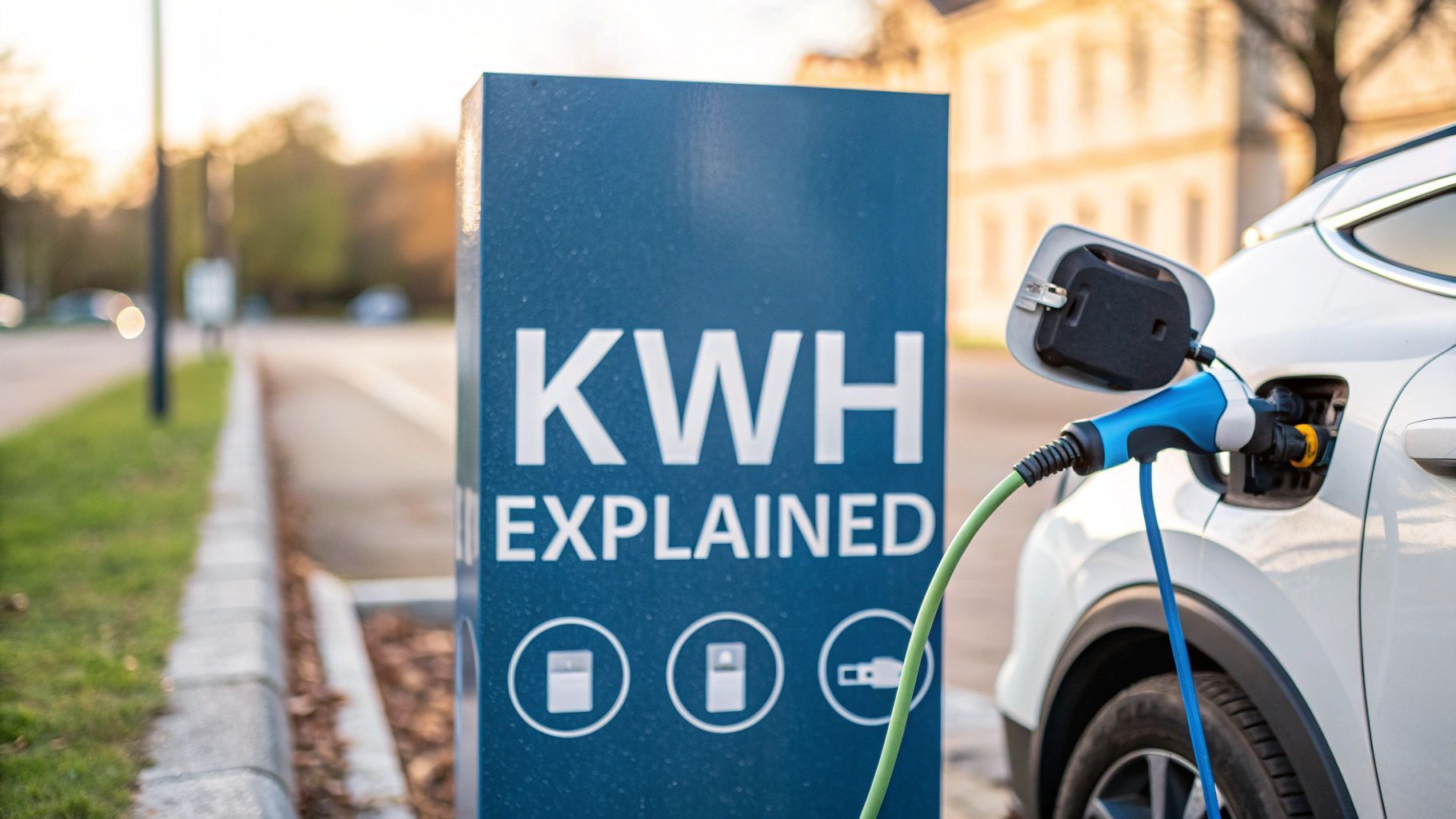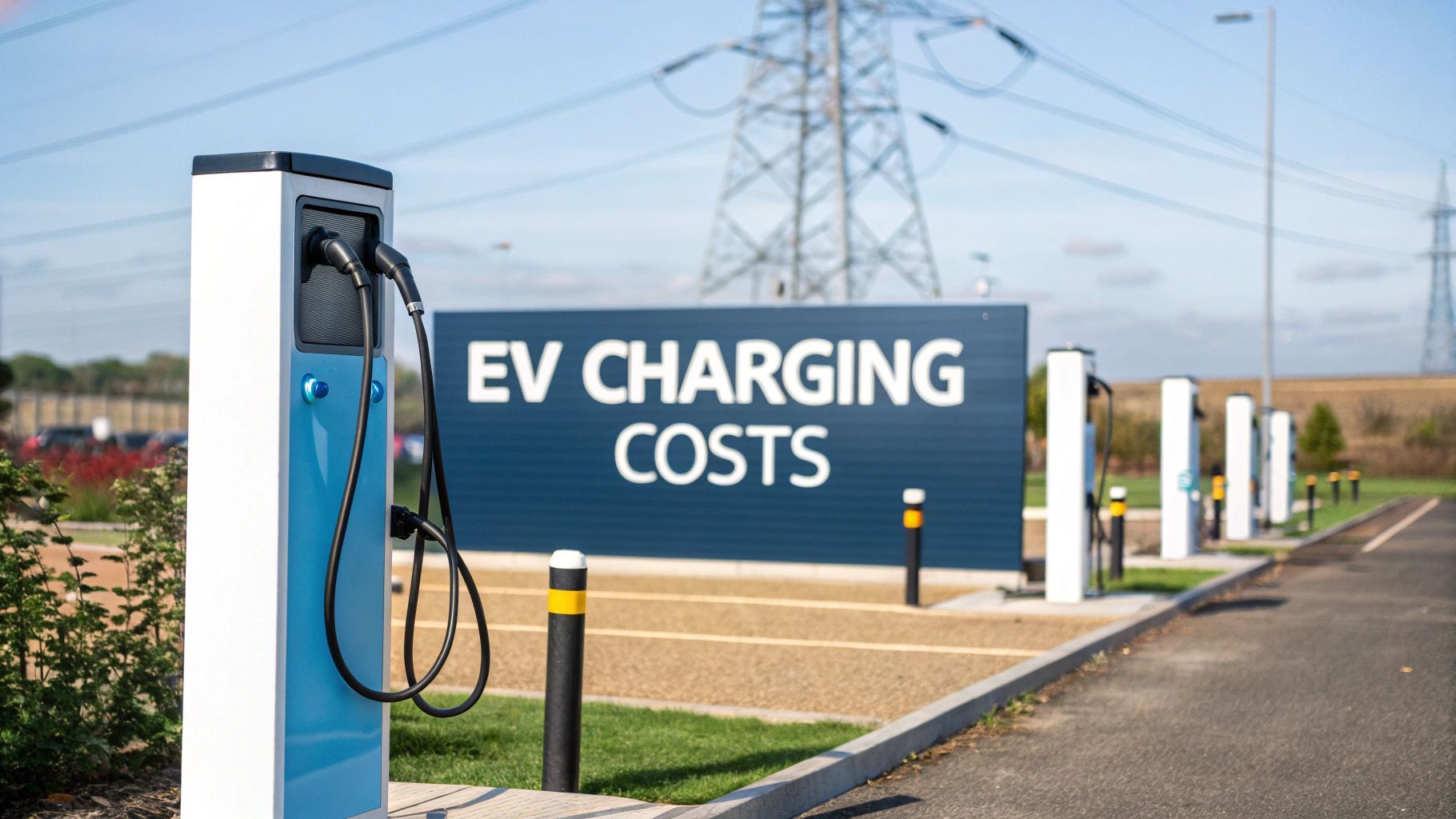High Capacity Battery Charger Guide
When you hear the term "battery charger", you probably picture the small plug you use for your phone or maybe the trickle charger for your car. But in the world of large-scale energy, we're talking about something entirely different.
A high capacity battery charger is an industrial-grade system built to deliver huge amounts of electrical power and fast. It completely outclasses standard consumer chargers, making it essential for demanding applications like rapid EV charging for commercial fleets , supporting grid-scale battery storage and powering mobile charging solutions.
Understanding the High Capacity Battery Charger
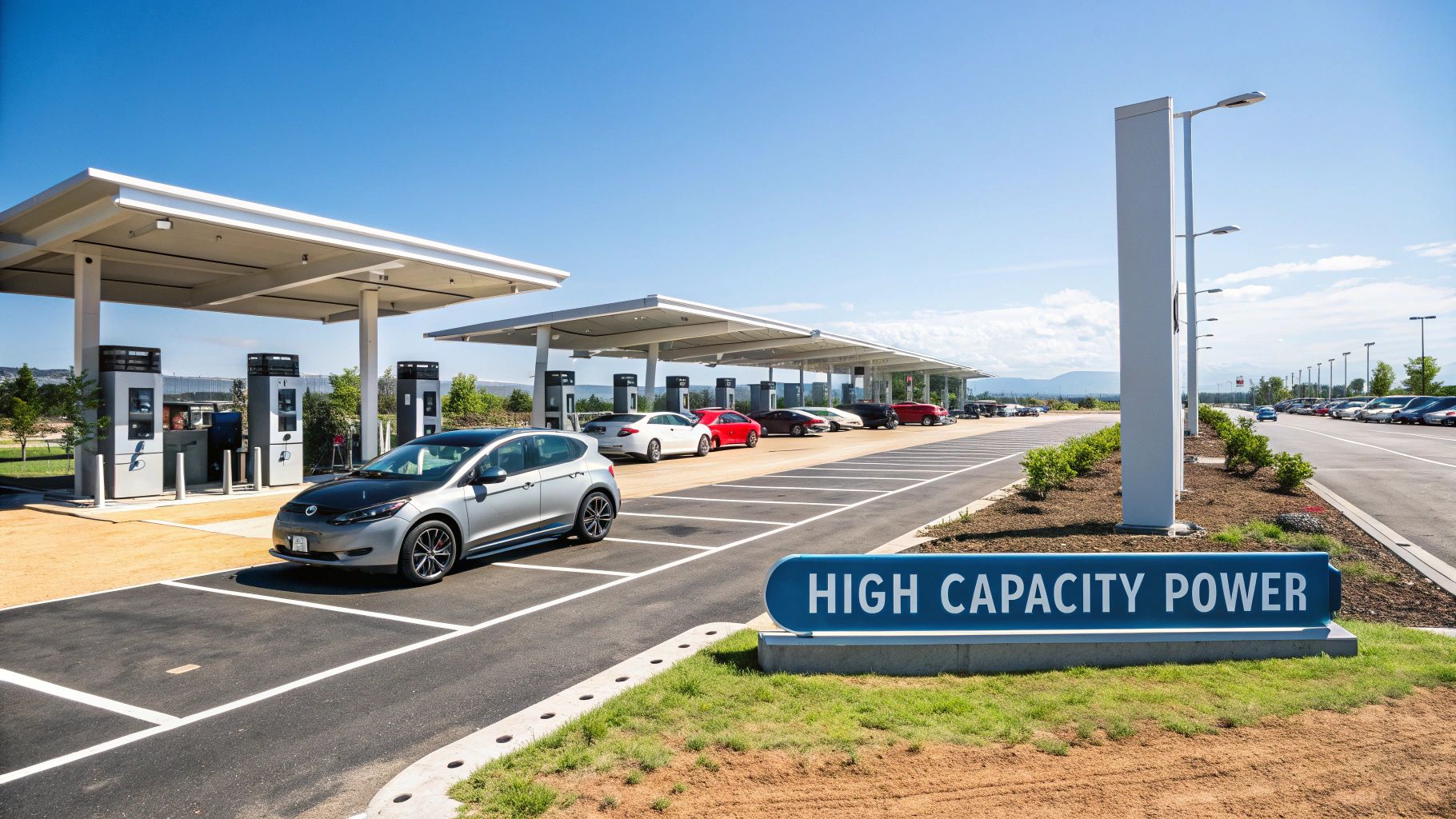
Let's go beyond a simple definition. Think of a standard charger—like the one for your personal car—as a quiet country lane. It gets the job done, delivering energy at a steady but slow pace, which is perfectly fine for overnight charging at home.
A high capacity battery charger on the other hand is the multi-lane motorway of energy transfer. It is engineered to handle a massive volume of power, making it indispensable for commercial and industrial operations where time is money and energy demand is significant. These systems are the backbone of modern EV fleets, major energy projects and distributed energy networks.
This is not a niche market; it reflects a fundamental shift towards electrification. The UK's battery charger market was valued at around USD 840.88 million in 2024 and is expected to climb to approximately USD 1.28 billion by 2034 . This growth is being fuelled by the massive uptake of electric vehicles and continuous innovation in high-speed charging technology.
Power and Energy Explained
To really get what makes these chargers special, you need to understand two core concepts: power and energy. It is a simple distinction but a crucial one.
-
Power (kW): Think of power as the speed at which water flows from a tap. A higher kilowatt (kW) rating means the charger can deliver energy faster, slashing charging times. Your standard home EV charger might be 3-7 kW , while high capacity rapid chargers can range from 50 kW to well over 350 kW .
-
Energy (kWh): Energy, measured in kilowatt-hours (kWh), is the total amount of water you can fit in the bucket. It represents the storage capacity of a battery. A bigger kWh value means the battery can power a vehicle for a longer distance.
A high capacity charger excels at delivering high power (kW) to fill up a large energy reservoir (kWh) in the shortest time possible.
The real difference lies in scale and speed. While a home charger might take 8-10 hours to fill an EV battery, a high capacity system can achieve an 80% charge in under 30 minutes—an absolute game-changer for any commercial operation.
To give you a clearer picture, here’s a quick comparison of the key characteristics that separate high-capacity chargers from the standard ones you see every day.
Standard vs High Capacity Chargers at a Glance
| Characteristic | Standard Charger | High Capacity Battery Charger |
|---|---|---|
| Typical Power Output | 3 kW - 22 kW | 50 kW - 350 kW+ |
| Primary Use Case | Home, workplace, public top-up | Commercial fleets, BESS, rapid hubs |
| Charging Speed | Slow (4-12 hours for a full charge) | Ultra-rapid (20-40 minutes for 80%) |
| Infrastructure Needs | Standard grid connection | Often requires grid upgrades or BESS |
| Technology Focus | Convenience and overnight charging | Speed, efficiency and grid integration |
As you can see, these are not just scaled-up versions of the same thing; they are fundamentally different systems designed for entirely different purposes.
Key Applications
These powerful systems are not just for public forecourts. Their applications are diverse and foundational to the UK's evolving energy infrastructure.
They are critical for:
- Rapid EV Charging Hubs: Powering depots for electric lorries, buses and delivery vans that cannot afford to wait.
- Mobile EV Charging: Enabling on-demand power for roadside assistance or providing temporary charging at events or construction sites.
- Grid Scale Batteries: Managing the rapid charge and discharge of large Battery Energy Storage Systems (BESS) that help stabilise the national grid.
- Combined On-Site Renewables: Storing excess energy generated from solar or wind installations for later use, creating a self-sufficient power source.
By integrating these advanced systems, businesses can overcome major challenges like constrained grid connections and build resilient, independent energy ecosystems. You can learn more about what makes this kind of advanced energy storage possible and how it integrates seamlessly with charging technology.
The Technology Driving a High Capacity Charger
To really get what makes a high capacity battery charger tick, we need to look under the bonnet. These systems are a world away from a simple plug socket; they're sophisticated pieces of engineering built to handle immense electrical loads safely and efficiently. The core technology inside is what allows them to transfer huge amounts of energy without breaking a sweat.
At the heart of it all, you’ll find advanced power electronics . Think of this as a highly skilled digital traffic controller for electricity. Its main job is to take raw, high-voltage power from the grid and convert it into the precise direct current (DC) that an EV battery needs. This conversion has to be incredibly accurate to avoid damaging the battery.
Just as critical is thermal management . Shifting hundreds of kilowatts of power generates a serious amount of heat. To deal with this, these chargers rely on advanced cooling systems, often using liquid coolants, to pull that heat away and keep everything operating within safe temperatures. Without it, a charger would overheat and shut down in minutes.
Smart Charging Protocols: The Brains of the Operation
Modern high capacity chargers do not just blindly push power. They rely on intelligent communication protocols to do their job properly. Imagine an air traffic control system for energy; it needs to be in constant contact with the aircraft (the EV) to ensure a safe and efficient journey. In the same way, these charging protocols create a digital handshake between the charger and the vehicle.
This two-way conversation manages several crucial factors:
- Battery Status: The charger gets live data on the battery’s current charge level, its temperature and the maximum charging rate it can safely accept.
- Power Adjustment: It fine-tunes the power output in real-time, matching what the battery can handle to prevent overheating or long-term damage.
- Safety Checks: The system is always on the lookout for faults or issues, ready to stop the process instantly if a problem pops up.
In the UK and Europe, two main standards govern this communication: CCS (Combined Charging System) and CHAdeMO . While most new European EVs now use the CCS standard, you will still find both out in the wild. These standards are the common language that allows different car brands to use the same public rapid charging network.
The Future of Charging: Bidirectional Power Flow
The technology inside a high capacity battery charger is not just about putting power into a vehicle anymore; it is increasingly about pulling it back out. This is known as bidirectional charging , or Vehicle-to-Grid (V2G) technology, and it is set to turn EVs from simple transport into mobile energy assets.
With V2G, a connected fleet of vehicles can act as one enormous, distributed battery. During peak times when the grid is under strain, these vehicles can collectively feed a small amount of their stored energy back to the grid, helping to balance it and prevent blackouts. Later, they can charge up when renewable energy is plentiful and cheap.
This capability is a game-changer for the national grid. It turns EV fleets into a powerful resource that supports grid stability and facilitates greater integration of intermittent renewable energy sources like wind and solar.
Of course, the battery chemistry inside the vehicle plays a massive part in how well it can handle these advanced charging and discharging cycles. Different lithium-ion technologies offer very different performance. You can explore a comparative overview of battery types to get a better sense of how they stack up in terms of durability and efficiency. It is this partnership between charger technology and battery chemistry that will unlock the true potential of distributed energy networks across the UK.
Pairing Chargers with Battery Energy Storage Systems
A high-capacity battery charger is a powerful bit of kit on its own but its true potential is unlocked when you pair it with a Battery Energy Storage System (BESS). This dynamic duo creates a formidable energy solution, capable of clearing one of the biggest hurdles to widespread rapid EV charging: weak or constrained grid connections.
Think of a BESS as a large energy reservoir. It can be filled up slowly and strategically, either by drawing power from the grid during cheap off-peak hours or by capturing free energy from on-site renewables like solar panels. Once full, this reservoir can unleash a huge surge of power on demand, feeding the high-capacity charger far beyond what the local grid could ever supply directly.
This diagram shows how that energy moves—from the grid, into a battery system for storage and then delivered to the vehicle through the charger.
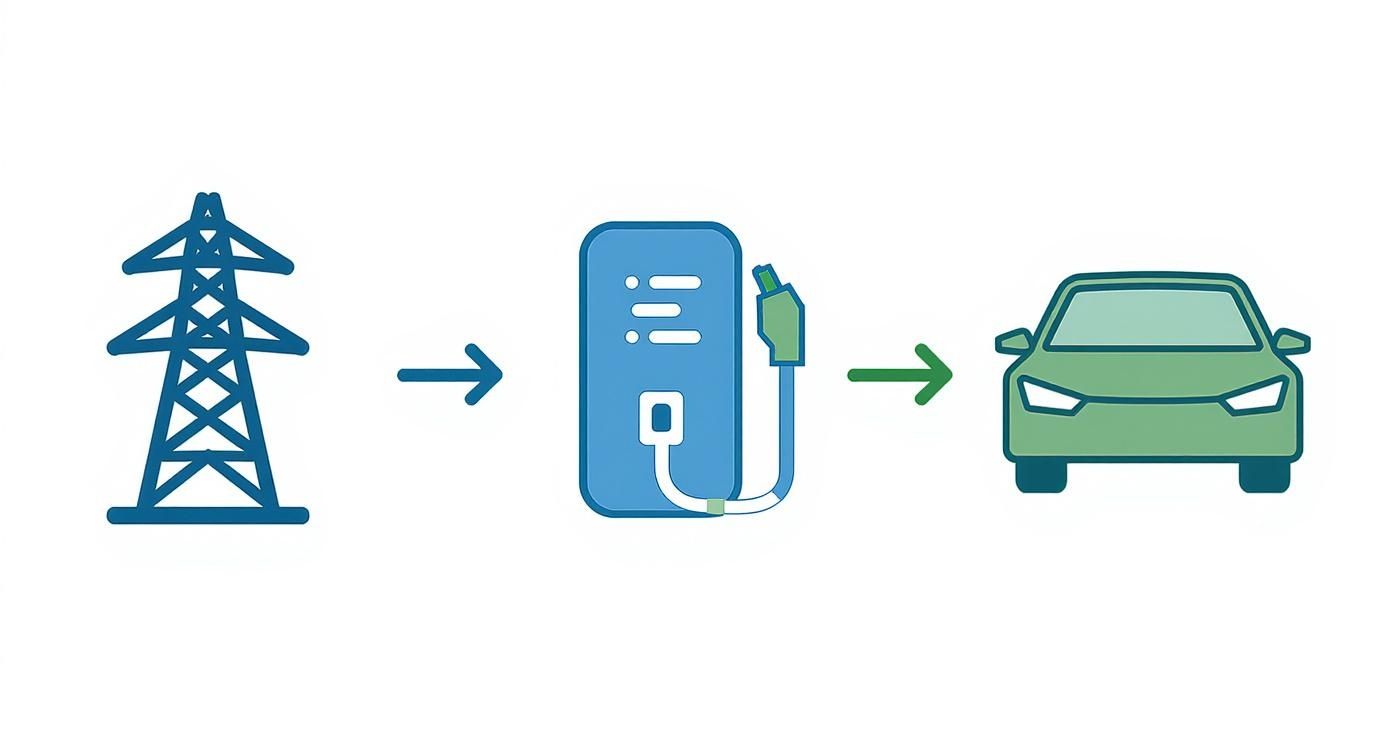
The key takeaway is that the BESS acts as a critical buffer. It effectively decouples the rapid charging event from the immediate capacity of the grid connection.
Overcoming Grid Constraints in the Real World
Picture a busy motorway service area. The demand for rapid EV charging is immense, with drivers needing to top up and get back on the road quickly. The problem is, the local grid connection was never designed for such a massive, sudden power draw. Upgrading it could cost hundreds of thousands of pounds and take years to complete.
This is where the BESS and high-capacity charger combination becomes essential. The BESS can spend all night and the quieter parts of the day sipping power from the grid at a low, manageable rate. When a stream of EVs arrives during the lunchtime rush, the BESS discharges its stored energy through multiple rapid chargers, providing a seamless experience for customers without ever overloading the grid.
This strategic approach transforms a grid-limited location into a profitable, high-throughput charging hub. It turns the problem of insufficient grid capacity into a simple logistical exercise in energy management.
This is not just a theoretical benefit; it is a practical solution being deployed right now at logistics depots, business parks and public charging sites across the UK. For fleet operators, it means they can transition to electric without waiting years for grid reinforcement works. For businesses, it provides a way to offer a valuable service and generate revenue.
The value of this integrated approach is becoming clearer as the UK's vehicle fleet electrifies. Projections show that the automotive sector will account for about 90% of total battery demand in the coming years. By 2035 , the UK is expected to need an additional 55 GWh of battery capacity, underscoring the vital role of smart charging and storage solutions.
Building a Distributed Energy Ecosystem
The synergy between a high-capacity charger and BESS is a cornerstone of the modern distributed energy model. Instead of relying solely on a distant, centralised power station, energy is generated, stored and used locally. This creates a far more resilient and efficient system.
This setup offers several key advantages:
- Cost Management: By charging the BESS with cheap, off-peak electricity, operators can avoid expensive peak-time tariffs and sell energy to drivers at a competitive rate.
- Renewable Integration: It allows for the maximum use of on-site renewables. Every kilowatt of solar power generated can be stored and used later, rather than being exported to the grid for a low price.
- Grid Services: In some cases, these systems can even provide services back to the grid, helping to balance supply and demand and creating an additional revenue stream.
By implementing these smart systems, businesses are not just installing EV chargers; they are building miniature, self-sufficient energy hubs. This is a fundamental shift in how we think about power. To get a deeper understanding of the technology involved, you can learn more about how battery-backed EV charging works and the specific benefits it can bring to your operations.
Unlocking Rapid and Mobile EV Charging Solutions
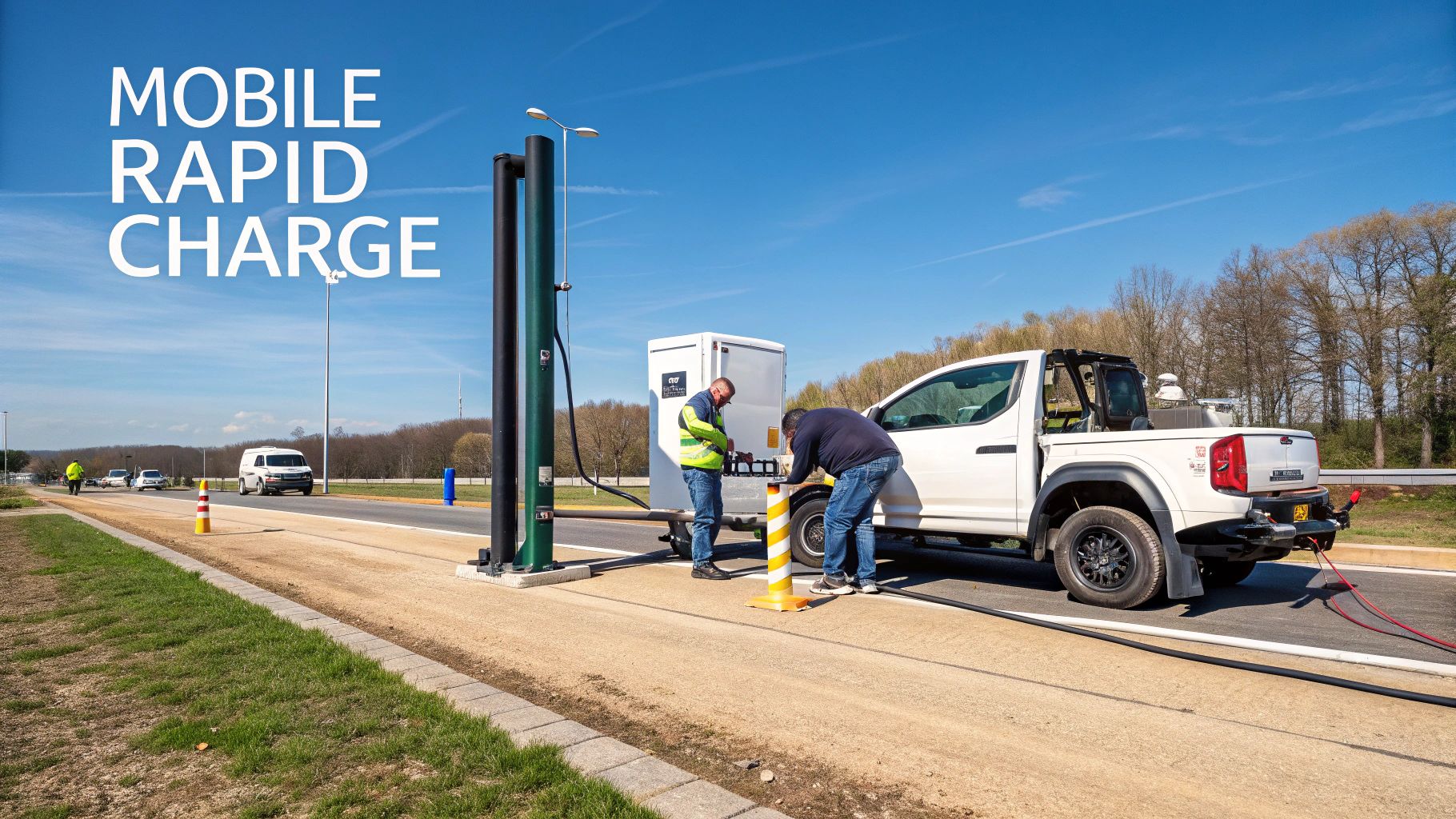
We’re seeing this technology reshape how power is delivered to EVs, from permanent, high-traffic hubs to agile, on-demand units. Two key applications really stand out: fixed rapid charging for entire fleets and innovative mobile charging solutions. Both tackle the urgent need for fast, reliable power but they do it in strategically different ways.
Powering Permanent Rapid Charging Hubs
For any commercial fleet operator, whether at a logistics depot or a busy motorway service station, vehicle downtime is a direct hit to the bottom line. Electric lorries, buses and delivery vans simply cannot afford to sit idle for hours while charging.
This is exactly where permanent rapid charging hubs, backed by high-capacity battery chargers, become an operational necessity.
These hubs are built for high throughput. By delivering power at rates of 150 kW , 350 kW or even higher, they can top up a significant portion of an EV's battery in the time it takes for a driver to take a legally required break. It is all about minimising downtime and keeping fleets on the move, ensuring delivery schedules are met without a hitch.
Often, integrating a BESS is what makes these sites viable. It lets operators install multiple ultra-rapid chargers without needing a prohibitively expensive grid upgrade. What could have been a major bottleneck becomes a manageable, cost-effective energy asset.
The goal is simple: to make refuelling an electric commercial vehicle as quick and seamless as its diesel predecessor. High capacity chargers make this possible, ensuring that the switch to electric is not just environmentally sound but also commercially viable.
The Rise of Mobile EV Charging
While permanent hubs are essential, there is a growing need for flexible, on-demand power. This has given rise to mobile EV charging—an ingenious solution that puts a high-capacity battery charger and a BESS onto a lorry or trailer. The result is a self-contained power source that can be deployed anywhere, anytime.
Think about a large outdoor music festival or a major sporting event. The temporary surge in EV charging demand would overwhelm any local infrastructure. A mobile charging unit can be driven straight to the site, providing multiple rapid charging points for attendees without any need for permanent installation.
This flexibility is a game-changer in several other scenarios:
- Emergency Roadside Assistance: Offering a rapid power boost to a stranded EV, getting the driver back on the road far quicker than a tow to a static charger.
- Temporary Sites: Providing power at construction sites or film sets before a permanent grid connection has been established.
- Fleet Support: Augmenting a depot's charging capacity during peak periods or offering "in-field" top-ups for vehicles that cannot make it back to base.
Mobile EV charging effectively decouples charging from a fixed location. It brings the power to the vehicle, not the other way around.
This approach is crucial for plugging the gaps in the UK's charging network, particularly in remote or underserved areas. By providing a reliable power source wherever it’s needed, these mobile units make EV ownership more practical and reassuring for a wider range of drivers and businesses, driving forward our national infrastructure with genuine agility.
Going Off-Grid with Renewables
Pairing a high capacity battery charger with a BESS is a smart move but the real magic happens when you connect this system to on-site renewables like solar panels. Suddenly, you have created a completely self-sufficient energy ecosystem where your business can generate, store and use its own clean power.
This setup flips the traditional energy model on its head. Instead of just being a passive customer paying whatever the grid demands, your organisation becomes an active player in its own energy supply. You are moving from simple consumption to genuine energy management, where power is generated cleanly and used exactly when and where you need it.
Creating Your Own Energy Ecosystem
Picture a logistics depot with a massive roof covered in solar panels. Throughout the day, those panels are soaking up the sun, generating huge amounts of clean electricity. A high capacity battery charger and BESS are standing by, capturing every single kilowatt that is not immediately needed to run the building.
That stored solar power is then ready to deliver rapid EV charging to the depot’s fleet overnight or even during the busiest hours of the day. The entire cycle—from generation to storage to charging—happens right there on-site, slashing your reliance on the national grid. This is the very heart of a distributed energy model.
In a distributed energy model, power is generated and managed locally, not sent over long distances from a central power station. This creates a tougher, more efficient and greener energy network. It turns EV charging from a massive grid expense into a strategic, locally-controlled asset.
This integrated approach does not just cut your operational costs by taking a huge bite out of your electricity bills. It also gives your company’s environmental credentials a serious boost, offering real proof of a commitment to sustainability—something customers, investors and regulators are paying more and more attention to.
The Power of Local Control
When you generate and store your own energy, you gain incredible control over your power supply and its costs. This local control turns a simple charging installation into a far more valuable part of your business.
Key Benefits of an Integrated System:
- Energy Security: You are far less vulnerable to grid outages or volatile energy prices. If the grid goes down or prices shoot up, your on-site system keeps your operations and vehicle charging running without a hitch.
- Cost Certainty: Relying on your own solar power gives you a predictable, low-cost source of energy for years. It is a powerful shield against the unpredictable electricity price hikes that are becoming all too common.
- Enhanced Sustainability: You are making the most of every drop of renewable energy, ensuring your vehicles are powered by genuinely clean electricity. This dramatically lowers your fleet's total carbon footprint.
This powerful setup is fast becoming a cornerstone of modern energy strategy. It lets businesses move beyond just installing chargers and start building a resilient energy infrastructure that truly supports their goals. By combining on-site renewables , a BESS and a high capacity battery charger , vehicle charging stops being just another overhead. It becomes a strategic advantage that pays back in both financial and environmental returns.
How to Choose the Right Charging Solution
Picking the right high-capacity battery charger is not just a technical purchase; it is a strategic investment in where your organisation is headed. Get it right and you will have an efficient, cost-effective charging infrastructure that is ready to grow with you. Get it wrong and the costs can quickly mount up.
This is about more than just grabbing the most powerful unit off the shelf. It is a careful process of matching the technology to your real-world operational needs and the physical limitations of your site. A bit of thoughtful evaluation now will prevent expensive mistakes down the line and deliver real value for years to come.
Assess Your Power and Site Requirements
First things first: you need a clear-eyed analysis of your energy needs. That means understanding what you require today and, just as importantly, forecasting how that will change as your EV fleet or energy demands expand.
Start by asking a few crucial questions:
- What power output do you actually need (kW)? Think about the vehicles you’re charging and how fast you need them back on the road. A depot for electric lorries will need much higher outputs—think 150 kW+ —than a site charging staff cars overnight.
- What can your grid connection handle? You absolutely must evaluate your existing grid connection. Can it support the high-power draw of a rapid charger or will you be facing a costly and time-consuming upgrade? This assessment often highlights the need for a BESS to act as a buffer.
- How will you scale up later? Do not just plan for today. Your solution should be modular, letting you add more charging points or expand your battery storage as your fleet grows.
A classic mistake is underestimating future demand. Choosing a system that can be easily scaled up protects your initial investment and ensures your setup stays fit for purpose as you electrify more of your fleet.
The Role of Smart Energy Management
A powerful charger is only half the story. The real magic lies in the software that controls it. Modern smart energy management software is the brain of the whole operation, making sure everything runs smoothly while optimising performance and keeping costs in check.
This is the software that allows you to:
- Schedule charging to automatically take advantage of cheaper, off-peak electricity tariffs.
- Balance the load across multiple chargers, so you never trip the breaker or exceed your site’s grid capacity.
- Integrate with renewables by intelligently directing solar power to either your BESS or straight into your vehicles.
The UK's charging network is growing but we have a long way to go. In 2025, 12,322 new public charging points were installed but most were slow chargers under 8 kW. The growth of intelligent, high-capacity solutions is vital for cutting down charge times and supporting the EV transition. Smart software is what unlocks that potential.
You can dive deeper into the data with the 2025 EV Charging Index for the UK.
Got Questions About High Capacity Chargers?
Diving into the world of high capacity chargers naturally brings up a lot of practical questions. As more businesses and organisations start looking seriously at rapid EV charging and large-scale energy storage, getting a clear picture of the costs, compatibility and real benefits is key to making the right call. Let's tackle some of the most common queries.
How Much Does a High Capacity EV Charging System Cost to Install?
Honestly, the final cost of a high capacity charging system can vary hugely. The main things that shape the price are the charger's power rating (kW), whether you need a supporting Battery Energy Storage System (BESS) and how much work needs doing on your site—like grid upgrades or digging trenches.
A simple rapid charger installation could start in the tens of thousands of pounds. But if you are looking at a full depot solution with a hefty BESS and integrated solar panels, you are talking about a major infrastructure project. That kind of investment can easily run into several hundred thousand pounds. The only way to know for sure is to get a detailed site survey and a quote built around your specific energy needs.
Can Any Electric Vehicle Use a Rapid Charger?
While most modern EVs are built to handle rapid charging, their maximum charging speed can be wildly different. Think of a vehicle's battery management system as a gatekeeper; it decides the absolute fastest rate the battery can safely take on power.
For example, a car designed for a 100 kW maximum charge rate will not charge any quicker just because you have plugged it into a 350 kW station. It will simply charge at its own top speed. The real beauty of a high capacity charger is that it guarantees every single vehicle can hit its personal best, whatever that may be. Commercial vehicles, like electric lorries and buses, are specifically designed to accept these really high power levels to get them back on the road as fast as possible.
The primary benefit is overcoming grid limitations and managing energy costs. A BESS allows you to install powerful, rapid chargers even where the local grid connection is weak.
What Is the Main Benefit of Pairing a Charger with a BESS?
Pairing a charger with a BESS is a smart move to get around grid restrictions and take control of your energy costs. It lets you install powerful rapid chargers in places where the local grid connection just is not strong enough to support them on its own.
Here’s how it works: the system slowly trickle-charges the battery storage from the grid when electricity is cheapest, usually overnight. This stored energy is then unleashed at high speed to charge vehicles during the day. This simple strategy helps you sidestep huge grid upgrade fees and protects your business from eye-watering peak-time electricity tariffs, making the whole operation much more affordable.
At ZPN Energy , we specialise in developing the integrated charging and battery storage solutions that power the future of transport and energy. Discover our advanced systems by visiting https://www.zpnenergy.com.


